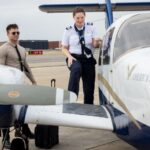From the beginning stages of our private pilot training, we know that a spin is an aggravated stall condition. During their training, the pictures shown to private pilot candidates in various publications generally show the airplane following a downward corkscrew path. Even worse, many of these pictures show the aircraft with its nose pointed straight down at the ground. Considering the definition and the pictures, no wonder so many people are afraid of spins.
Normal human behavior dictates that people stay away from things they fear. Human behavior also proves that as we get older, we learn that the boogie man does not live under our beds, there are no monsters in the attic, and all of the “scary creatures” that come out on Halloween are fake. The key word here is “learn.”
If a person can learn that so many of the things that once scared them are not actually scary, why are so many pilots scared of spins? The main answer to this question is somewhat simple: lack of knowledge and understanding of what a spin is and what happens during a spin.
Pilots are taught spin avoidance during the private, instrument, and commercial training. It is not until a pilot progresses to their flight instructor training that the actual spin is introduced.
Far 91.307(C) states that (C) unless each occupant of the aircraft is wearing an approved parachute, no pilot of a civil aircraft carrying any person
(other than a crew member may execute any intentional maneuver that exceeds—
(1) A bank of 60 degrees relative to the horizon; or
(2) A nose-up or nose-down attitude of 30 degrees relative to the horizon.
Far 91.307(D) continues on to state that
(D) paragraph (c) of this section does not apply to —
(1) Flight tests for pilot certification or rating; or
(2) Spins and other flight maneuvers required by the
regulations for any certificate or rating when given by:
(I) a certificated flight instructor; or
(Ii) an airline transport pilot instructing in accordance with § 61.67 Of this chapter.
Many pilots are not taught how to do spins because there is much confusion over when spins can be taught and whether a parachute needs to be worn or not. In its February 15, 2018 interpretation of “Fitzpatrick-Spartan College,” the FAA clarified that as long as a flight instructor provides spin training, neither the student nor the instructor must wear a parachute.
Many instructors are now confused about whether they can or cannot teach spins and to whom they can teach spins. Furthermore, many instructors have only done a minimum number of spins to get their spin endorsement. This usually gets them the signature in the logbook, but it is a far cry from making the instructor feel comfortable and confident enough to teach spins.
All pilots, especially flight instructors, should approach their spin endorsement the same way they approach the rest of their training. A thorough ground session should be completed to provide the candidate with a clear understanding of what a spin is, what is happening to the wings during the spin, and what the control inputs do to stop the spin and help the pilot recover from the spin. Spin candidates should understand the difference between a spin and a steep spiral. Understanding this will help them understand the proper procedure for spin entry and recovery.
There is a difference between learning spins for flying aerobatics in a fully aerobatic aircraft and learning spins for flying your family and friends in your Cessna 172. Many aerobatic airplanes are inherently unstable, allowing the pilot to perform many different types of aerobatic maneuvers. Many training aircraft, such as the Cessna 172, are inherently stable, so the entry into a spin will be very different. A pilot has to work to get the 172 to spin.
So, if you received your spin endorsement in a super decathlon, you will still want to get checked out by another instructor to conduct spins in a Cessna 172.
You owe it to your students to take your time and teach spins on the ground, starting with a full explanation of stalls. Then, progress into spins and show the students that just because you are spinning does not mean your nose is pointed directly at the ground or the aircraft is out of control. In other words, give them confidence through knowledge before you demonstrate the spin in the airplane. This will reduce their anxiety level and ensure they get the most out of the spinning experience.
Remember, the most effective way to teach stall and spin avoidance is to make sure your students understand what a stall and spin are and what conditions lead to a spin. This will ensure they avoid those situations leading up to the stall or the spin in the first place.










